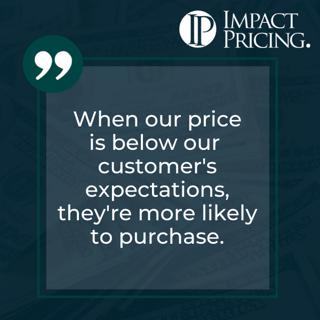
Memecast #45: Reference Prices
There's a concept in economics, behavioral economics, called reference prices. And reference prices really say our customers have some expectation about what they think they're going to pay. And if our price is below that expectation, they get a good feeling they're getting a good deal. And the fact that they're getting a good deal provides them an incentive or the good feelings that say I'm actually going to buy. Richard Thaler broke this up into two different types of utility. There's transaction utility and there's functional utility. The functional utility is the utility that someone gets from our product. It's the reason they're buying it. But transactional utility is the feelings you get when you're going to buy something. And if you walk into a store expecting to pay $20, and you find it on sale for 15, you're thinking, Hey, that's a really neat deal, I'm going to buy that. Or you're more likely to buy it. "We should be paying attention to our customer's expectations." - Mark Stiving If we have a way to control expectations, to raise expectations before they actually buy, and then we give them a price that's below those expectations, it makes it more likely they'll pull out their wallet and buy from us. We hope you enjoyed this podcast. If you see have any questions or feedback please email me mark@impactpricing.com. Now go make an impact. Connect with Mark Stiving: Email: mark@impactpricing.com LinkedIn
16 Feb 20221min
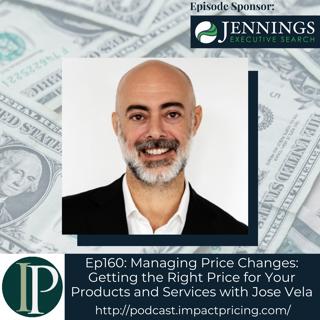
Managing Price Changes: Getting the Right Price for Your Products and Services with José Vela
José Vela is the Director of Pricing at Spandex Barcelona, known as one of the leading suppliers of graphics and digital materials worldwide. He is a strategic and business savvy leader who empowers business development and profitability improvements for global businesses, with an expertise in directing international trade, manufacturing, and services operations. José moved into pricing after having a General Manager's role. In this episode, José talks about the importance of getting the right price in selling your services as he relates it to the change and value you’re providing to your customers. Why you have to check out today’s podcast: Understand why it’s a must for you to be able to price your products and services right in relation to winning more deals even at a high price; Discover how experience adds up to a pricing person’s credibility, therefore, resulting to high rates of success in sales; and Find out how necessary it is for you to think like your customers in order to provide the best value in the market. “You need to be able to analyze your own data in order to identify where your margin, your profitability is, what are the leakages, and then you need to act on them.” – José Vela Topics Covered: 01:49 – Getting into the world of pricing: Winning more deals through knowing the right price 05:52 – General managers providing more credibility to the table and being able to demonstrate success through experience 09:00 – The value being present on the extended product; thinking like the customers 13:15 – Building the analytics capability to prove the impact of pricing decisions 16:49 – Why list prices matter so much 18:00 – How to effectively manage list prices in relation to the benchmarks 23:07 – José’s piece of pricing advice for today’s listeners Key Takeaways: “Most of the time, sales people – they are driven when we are talking about pricing. They are driven by fear. They are afraid of losing the deal, losing the customer if they base off them. And if you are able to provide them data, reliable information, they feel more confident and they know that they can offer a right price and they know it right because other similar customers are paying.” – José Vela “Country managers are really competitive. We are competitive animals and we know to overperform. We want to overachieve. And if we see that some of our colleagues are succeeding, we want to know what's the deal, what's going on there, because we want to replicate this, these tools, those processes, whatever they are doing to succeed. We want to make sure that we are doing the best in order to succeed too. So, if you are able to find early adopters that are able to show and demonstrate quick wins, this also helps a lot.” – José Vela “The impact of pricing is, how do we manage the list prices? And how do we manage the discounts that we are giving to our customer? The main driver for margin value is – without any doubt – how do you manage your pricing? And if you are not able to organically growth a lot for whatever the reason, how you manage your list prices is the biggest driver to increase your revenue.” – José Vela “In general, it's not just pricing the prices. It’s making the right price. Pricing goes in two directions. It’s not only about rising prices. Sometimes, you decrease.” – José Vela “Most of the pricing initiatives, the critical piece is never the technology, or at least from my point of view, because there are different ways to do stuff, different platforms, but how do you manage the change? How do you train the people? How do you make them feel comfortable and embrace the change? That's the most difficult part. Ever. Always.” – José Vela People / Resources Mentioned: Spandex: https://www.spandex.com/ Toyota: http://www.toyota.com/ Connect with José Vela: LinkedIn: https://www.linkedin.com/in/jvela/ Email: jjvelar@gmail.com Connect with Mark Stiving: LinkedIn: https://www.linkedin.com/in/stiving/ Email: mark@impactpricing.com
14 Feb 202226min

Blogcast #41: Opportunity Costs and Pricing
This is an Impact Pricing Blog published on January 5, 2021, turned into an audio podcast so you can listen on the go. Read Full Article Here: https://impactpricing.com/blog/opportunity-costs-and-pricing/ If you have any feedback, definitely send it. You can reach us at mark@impactpricing.com. Now, go make an impact. Connect with Mark Stiving: Email: mark@impactpricing.com LinkedIn
11 Feb 20223min
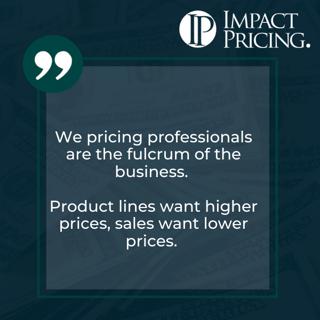
Memecast #44: Fulcrum
As pricing professionals, we really need to be the logical part of the business. Our product lines, they really want higher prices. Sometimes they become emotionally involved with their products and they think that they're worth a ton - and they probably are. Have we explained the value to the customers? Are we able to capture all those higher prices? "We pricing professionals are the fulcrum of the business. Product lines want higher prices, sales want lower prices. " - Mark Stiving And what we want to do as pricing people is make sure we understand whether or not we're communicating value well to the marketplace. And if we're not communicating value, maybe we're discounting so that we can at least win some business. So we're almost like the dispassionate referee. We're trying to say, hey, it makes more sense for us to price this way if we want to maximize profits. On the other hand, salespeople, customers too, what lower prices. Salespeople have prices, one of their tools to close a deal. When a customer asks for a lower price, it's easy for sales to come back inside and ask us for lower price. Again, we need to be that dispassionate referee. Have we truly explained the value to the customer? Do we know how much value that customer is going to be getting? And can we hold that price up a little bit without going for deep discounts? So in the end, we, the pricing professionals, are that fulcrum. We're trying to find the logical center of where prices should be. We hope you enjoyed this podcast. If you see have any questions or feedback please email me mark@impactpricing.com. Now go make an impact. Connect with Mark Stiving: Email: mark@impactpricing.com LinkedIn
9 Feb 20222min
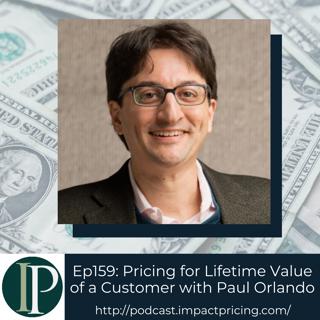
Pricing for Lifetime Value of a Customer with Paul Orlando
Paul Orlando is the Founder of Startups Unplugged and is the author of the book “Growth Units”, a book that makes unit economics straightforward. He builds incubator/accelerator programs around the world, getting companies to solve problems that they couldn’t in other ways, which allows the building of autonomy and skills that keeps employee retention high and maintains the company’s top talent. Paul is an adjunct professor and runs the incubator at USC. In this episode, Paul talks about calculating lifetime value as he shares why it is important to think about pricing in relation to the LTV. Why you have to check out today’s podcast: Understand the relationship lifetime value has with pricing and why it’s better to learn early and often than to fail fast Find out why overpricing and underpricing are present in various companies Discover why your lifetime value isn’t and will never be limited to one number “People are really afraid of raising prices. I think it was Marc Andreessen who said, 'a lot of problems go away if you can raise your prices.'” – Paul Orlando Topics Covered: 01:22 – How Paul got into the work of running incubators 03:16 – Building incubators and accelerators inside a company and changing the way people work to achieve a certain goal 06:05 – Why ‘learn early, learn often’ is a lot better than ‘fail fast’ 08:32 – Writing a book about calculating lifetime value and its components; why thinking about pricing is important 17:15 – Pricing and lifetime value; discussion about over- and underpricing 21:00 – Thinking about lifetime value in relation to subscription and non-subscription businesses 26:03 – Your lifetime value is and will never be limited to one number; why you should model the sequence of flows 29:56 – Why Paul prefers using payback time as a metric as opposed to LTV/CAC 31:23 – Paul’s pricing advice for this episode’s listeners Key Takeaways: “I actually don't want people to fail fast. I don't want them to fail slow, either. But I'd rather that they succeed fast, or second-best – succeed slow. So, I'd like to say, learn early learn often rather than fail fast. Learn early - encounter the customer upfront rather than downstream, and learn often - keep that process going like you really probably have not figured everything out just yet. You need to keep iterating. There's so much that you could test before you have committed serious resources.” – Paul Orlando “If price is some metric of value or some measure of value, you want to be able to charge something. You don't necessarily want a business that has to push prices as low as possible.” – Paul Orlando “Lifetime value is not something that you can really get a full picture of until you've been out for a while.” – Paul Orlando “These ratios or numbers that you hear about can be misleading unless you actually start digging in a bit.” – Paul Orlando “If you can start to either shorten that time, taking pre-orders, or if there's something that you can do with your own supply chain, tough today, but if there's something that you could do there, you could improve your odds of being able to use customer revenue to grow.” – Paul Orlando People / Resources Mentioned: Growth Units: Learn to Calculate Customer Acquisition Cost, Lifetime Value, and Why Businesses Behave the Way They Do: https://www.amazon.com/dp/B08GJVV8RJ/ Win Keep Grow: How to Price and Package to Accelerate Your Subscription Business: https://www.amazon.com/Win-Keep-Grow-Accelerate-Subscription/dp/1631954784 MoviePass: https://www.moviepass.com/ Uber: https://www.uber.com/ Dollar Shave Club: https://www.dollarshaveclub.com/ Amazon Web Services: https://aws.amazon.com Coke: https://us.coca-cola.com/ Connect with Paul Orlando: LinkedIn: https://www.linkedin.com/in/porlando/ Email: orlando@gmail.com Twitter: https://twitter.com/porlando Connect with Mark Stiving: LinkedIn: https://www.linkedin.com/in/stiving/ Email: mark@impactpricing.com
7 Feb 202232min

Blogcast #40: Call It Customer Impact!
This is an Impact Pricing Blog published on December 29, 2021, turned into an audio podcast so you can listen on the go. Read Full Article Here: https://impactpricing.com/blog/call-it-customer-impact/ If you have any feedback, definitely send it. You can reach us at mark@impactpricing.com. Now, go make an impact. Connect with Mark Stiving: Email: mark@impactpricing.com LinkedIn
4 Feb 20222min
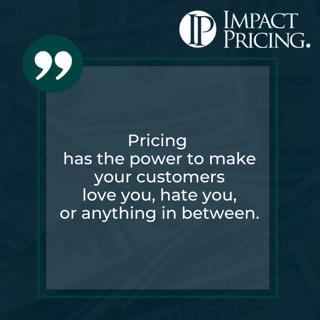
Memecast #43: Pricing has Emotional Power
As far as loving you is concerned, obviously, they love low prices; they love discounts. But the real love happens when we can deliver a ton more value than what they expected, what they actually have to pay for. These are the raving fans, the people who really value our products. And yet we couldn't capture all of that value even if we wanted to. “Pricing has the power to make your customers love you, hate you, or anything in between.” - Mark Stiving As to hating you, customers will absolutely hate you when you raise their prices without some reasonable explanation, without doing something nice for them, because customers hate price increases. And of course, if our pricing is just ridiculous; if it's horrible, for whatever reason, they will learn to hate us. So pricing really is very powerful, it causes emotions inside our customers. We want to make sure we're managing those emotions carefully. We hope you enjoyed this podcast. If you see have any questions or feedback please email me mark@impactpricing.com. Now go make an impact. Connect with Mark Stiving: Email: mark@impactpricing.com LinkedIn
2 Feb 20221min
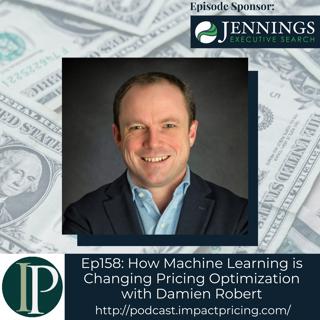
How Machine Learning is Changing Pricing Optimization with Damien Robert
Damien Robert is currently the Chief Solution and Delivery Officer at Pricemoov. He's been at Simon-Kucher & Partners (SKP) for 17 years of his career so he actually understands pricing really well. Damien also took a three-year stint at Disneyland Resorts Paris. Damien develops and implements tailor-made pricing solutions, ensuring easy price steering across the organization. In this episode, Damien talks about Machine Learning and how it helps optimize inputs in the pricing work as he shares insights in relation to Pricemoov’s models. Why you have to check out today’s podcast: Find out what Machine Learning (ML) and Artificial Intelligence (AI) are all about and how these two are used in pricing Discover simple and advanced pricing strategies you can implement to reach a bigger market Understand why looking at price in the perspective of your client is a good move towards success “Look at your prices with the client view.” – Damien Robert Topics Covered: 01:32 – How Damien got into pricing 02:34 – What does pricing mean for Damien 04:28 – Damien’s pricing story when he was still in Disneyland 06:25 – What makes Pricemoov different in the pricing market and how Damien got involved with them 08:50 – Simple and advanced pricing strategies people can implement 10:57 – Collecting competitive pricing information with car rental companies 13:00 – Defining Machine Learning (ML) and Artificial Intelligence (AI) alongside the things they do 16:45 – Using ML to forecast the effects of the decisions made for pricing 19:54 – Mark’s Amazon story: his $20 book reaching a price $225 in Amazon 22:00 – Damien working in a theme park, the existence of black box 24:57 – The things Pricemoov considers when making pricing models 27:00 – Damien’s pricing advice for today’s listeners Key Takeaways: “Pricing is not only a price, but also the way you message it and what you can achieve.” – Damien Robert “Our software is allowing you to configure the rules that we provide. So, you have a set of rules, you, yourself, decide which one you want to use and implement for your product portfolio, because you may want to use one or another one, and we can basically train you on which one you want to use.” – Damien Robert “That's what people misunderstand. Sometimes in machine learning and artificial intelligence, they think that the model by itself can be smart. The reality is that the model is not smart, but the model can be much more granular and fit much more kind of situations because his granularity and the computer allows, basically, to have so many computations and so many different alternatives.” – Damien Robert “Somehow, machine learning can be used to optimize part of the dimension, some of the inputs, but basically, at the end of the day, you need a skeleton of decision making, which is important to have. Otherwise, you do not take the long-term impact of price changes. You do not take the potential competition reaction. So, you're missing a lot of the points.” – Damien Robert “Very frequently, you just optimize, set a price, but you do not check the consistency, you do not realize some of the price points, and you won't even realize that the way your prices are featured on the web is sometimes a catastrophe. So really, just look at the end of the tunnel and look at it because you will have a lot of surprise, especially on promotion. 50% of promotional faders are usually related to execution. It's not at all related to the design of the promotion itself.” – Damien Robert People / Resources Mentioned: Pricemoov: https://pricemoov.com/ Simon-Kucher & Partners: https://www.simon-kucher.com Tesla: https://www.tesla.com/ Connect with Damien Robert: LinkedIn: https://www.linkedin.com/in/damienrobertpricemoov/# Email: robert@pricemoov.com Connect with Mark Stiving: LinkedIn: https://www.linkedin.com/in/stiving/ Email: mark@impactpricing.com
31 Jan 202228min






















